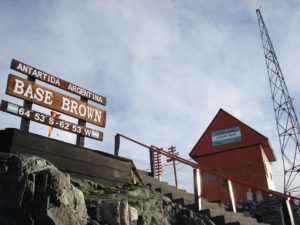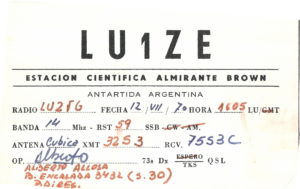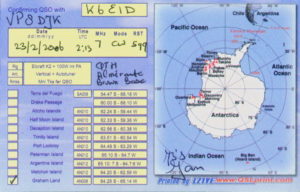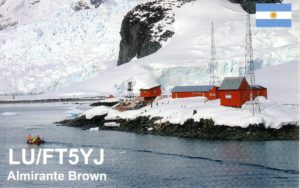 Brown Station (WAP ARG-Ø2) is an Argentine Antarctic Base and scientific research station named after Admiral William Brown, the father of the Argentine Navy.
Brown Station (WAP ARG-Ø2) is an Argentine Antarctic Base and scientific research station named after Admiral William Brown, the father of the Argentine Navy.
It is located on Sanavirón Peninsula along Paradise Harbor, Danco Coast, in Graham Land, Antarctic Peninsula. As of 2014, Brown is one of 13 research bases in Antarctica operated by Argentina.
From 1951 to 1984 it served as a permanent base; since then it is open during the summer season only. Brown Station dates to 6 April 1951, when Argentina established the Almirante Brown Naval Detachment at Paradise Harbor. In January 1956, the Argentine Navy inaugurated the Refugio Naval Conscripto Ortiz (Conscripto Ortiz Naval Refuge). The detachment worked as a meteorological observatory and as a base for Antarctic campaigns until it was temporarily closed in 1960.
The Argentine Antarctic Institute took over the station in 1964–65, creating one of the most complete biology laboratories on the Antarctic Peninsula. It included a main house of 292 m2 (3,140 sq ft); two folding 30,000 l (6,600 imp gal; 7,900 US gal) fuel tanks; and an additional building exclusive for scientific research, equipped with three labs, photography workshop, emergency radio station, office and library. It was called Almirante Brown Research Station and inaugurated on 17 February 1965. Brown Station’s original facilities were burned down by the station’s doctor on 12 April 1984. Station personnel was rescued by the ship USS Hero and taken to United States’s Palmer Station. Argentina rebuilt the base but it was demoted to summer-only status.
 During the summer campaign of 1995–96 the Logistics Department of the Argentine National Antarctic Directorate built two new habitable modules: a laboratory and a house with amenities. In the 1999–2000 campaign the Directorate built a new main house capable of comfortably accommodating 8 people; the new building consists of 4 bedrooms, kitchen and 2 bathrooms. Brown slipped into several years of inactivity during the 2000s decade but since 2007 is occupied during the summer again. Paradise Harbor is a large sea inlet southwest of Andvord Bay protected by an arc formed by the Lemaire, Cramer and Bryde islands. Along the harbor’s deep water coast lies the small Sanavirón Peninsula, a rocky promontory crowned by a mound of almost 70 m (230 ft) high called Punta Proa, where the base facilities are located. In the area there are several beacons to help ship guidance: Punta Proa, in the homonymous place; Punta Vidt in General Ricchieri Cove; Punta Conesa, on the entrance to Puerto Leith; Hanka islet on the homonymous place in Paradise Harbor; Punta Piedras in Oscar Cove; and the lighthouse on Cramer Island.
During the summer campaign of 1995–96 the Logistics Department of the Argentine National Antarctic Directorate built two new habitable modules: a laboratory and a house with amenities. In the 1999–2000 campaign the Directorate built a new main house capable of comfortably accommodating 8 people; the new building consists of 4 bedrooms, kitchen and 2 bathrooms. Brown slipped into several years of inactivity during the 2000s decade but since 2007 is occupied during the summer again. Paradise Harbor is a large sea inlet southwest of Andvord Bay protected by an arc formed by the Lemaire, Cramer and Bryde islands. Along the harbor’s deep water coast lies the small Sanavirón Peninsula, a rocky promontory crowned by a mound of almost 70 m (230 ft) high called Punta Proa, where the base facilities are located. In the area there are several beacons to help ship guidance: Punta Proa, in the homonymous place; Punta Vidt in General Ricchieri Cove; Punta Conesa, on the entrance to Puerto Leith; Hanka islet on the homonymous place in Paradise Harbor; Punta Piedras in Oscar Cove; and the lighthouse on Cramer Island.
 Brown is located 1,100 km (680 mi) from Ushuaia, the nearest port city. As of 2014 the base spans a total area of 1.4 ha (14,000 m2; 150,000 sq ft). It can house a maximum of 18 people. Research programs were developed for biology (zoology and botany), bacteriology, limnology, biochemistry, animal and human physiology, pathology, ecology, oceanography, meteorology, cosmic rays and ionospheric observations, environmental nuclear radiation, continental and sea ice glaciology, satellite geodesy, geology, geophysics, seismology, ozone monitoring and tide measurement.
Brown is located 1,100 km (680 mi) from Ushuaia, the nearest port city. As of 2014 the base spans a total area of 1.4 ha (14,000 m2; 150,000 sq ft). It can house a maximum of 18 people. Research programs were developed for biology (zoology and botany), bacteriology, limnology, biochemistry, animal and human physiology, pathology, ecology, oceanography, meteorology, cosmic rays and ionospheric observations, environmental nuclear radiation, continental and sea ice glaciology, satellite geodesy, geology, geophysics, seismology, ozone monitoring and tide measurement.
 Throughout the years of research and observations at Brown, more than 100 scientific papers were published by the Argentine Antarctic Institute. Thanks to its location on the Antarctica continent along the beautiful Paradise Harbor and to its relatively mild weather, Brown Station is a popular excursion destination for tourist expedition ships visiting Antarctica. In addition to visiting gentoo penguins, tourists may climb to a viewpoint 84 m (276 ft) above the station.
Throughout the years of research and observations at Brown, more than 100 scientific papers were published by the Argentine Antarctic Institute. Thanks to its location on the Antarctica continent along the beautiful Paradise Harbor and to its relatively mild weather, Brown Station is a popular excursion destination for tourist expedition ships visiting Antarctica. In addition to visiting gentoo penguins, tourists may climb to a viewpoint 84 m (276 ft) above the station.
Almirante Brown (WAP ARG-Ø2) has been active sporadically from 1979 throug 2004 by LU1ZB & LU1ZE. It is considered a rare one. On 2006 VP8DJK was briefly active from there as well. Last activity was performed on 1 & 2 march 2009 by Mehdi F5PFP signing LU/FT5YJ
